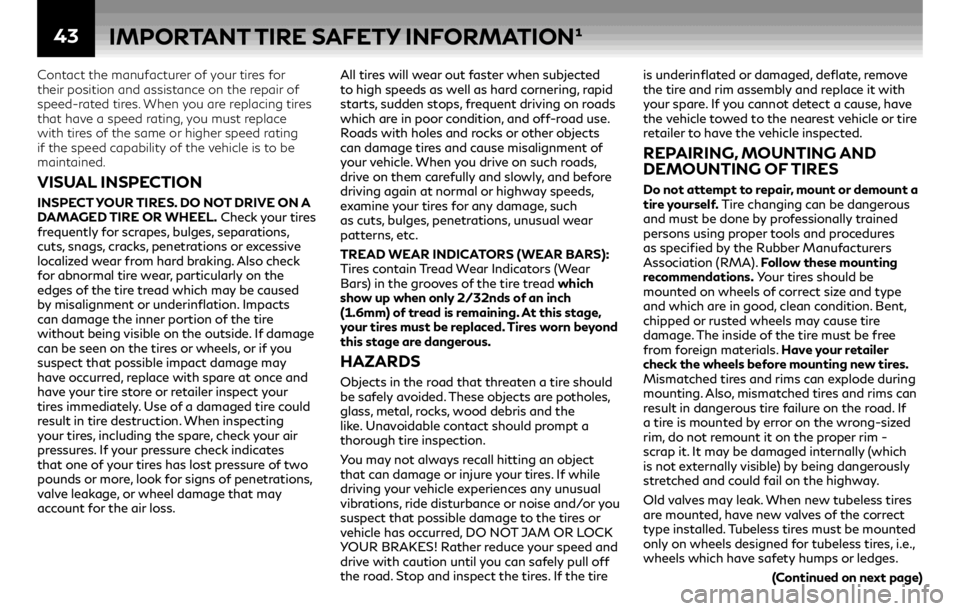tow bar INFINITI Q50 2019 Warranty Information Booklet
[x] Cancel search | Manufacturer: INFINITI, Model Year: 2019, Model line: Q50, Model: INFINITI Q50 2019Pages: 60, PDF Size: 0.25 MB
Page 46 of 60

43
Contact the manufacturer of your tires for
their position and assistance on the repair of
speed-rated tires. When you are replacing tires
that have a speed rating, you must replace
with tires of the same or higher speed rating
if the speed capability of the vehicle is to be
maintained.
VISUAL INSPECTION
INSPECT YOUR TIRES. DO NOT DRIVE ON A
DAMAGED TIRE OR WHEEL. Check your tires
frequently for scrapes, bulges, separations,
cuts, snags, cracks, penetrations or excessive
localized wear from hard braking. Also check
for abnormal tire wear, particularly on the
edges of the tire tread which may be caused
by misalignment or underinflation. Impacts
can damage the inner portion of the tire
without being visible on the outside. If damage
can be seen on the tires or wheels, or if you
suspect that possible impact damage may
have occurred, replace with spare at once and
have your tire store or retailer inspect your
tires immediately. Use of a damaged tire could
result in tire destruction. When inspecting
your tires, including the spare, check your air
pressures. If your pressure check indicates
that one of your tires has lost pressure of two
pounds or more, look for signs of penetrations,
valve leakage, or wheel damage that may
account for the air loss.All tires will wear out faster when subjected
to high speeds as well as hard cornering, rapid
starts, sudden stops, frequent driving on roads
which are in poor condition, and off-road use.
Roads with holes and rocks or other objects
can damage tires and cause misalignment of
your vehicle. When you drive on such roads,
drive on them carefully and slowly, and before
driving again at normal or highway speeds,
examine your tires for any damage, such
as cuts, bulges, penetrations, unusual wear
patterns, etc.
TREAD WEAR INDICATORS (WEAR BARS):
Tires contain Tread Wear Indicators (Wear
Bars) in the grooves of the tire tread which
show up when only 2/32nds of an inch
(1.6mm) of tread is remaining. At this stage,
your tires must be replaced. Tires worn beyond
this stage are dangerous.
HAZARDS
Objects in the road that threaten a tire should
be safely avoided. These objects are potholes,
glass, metal, rocks, wood debris and the
like. Unavoidable contact should prompt a
thorough tire inspection.
You may not always recall hitting an object
that can damage or injure your tires. If while
driving your vehicle experiences any unusual
vibrations, ride disturbance or noise and/or you
suspect that possible damage to the tires or
vehicle has occurred, DO NOT JAM OR LOCK
YOUR BRAKES! Rather reduce your speed and
drive with caution until you can safely pull off
the road. Stop and inspect the tires. If the tire is underinflated or damaged, deflate, remove
the tire and rim assembly and replace it with
your spare. If you cannot detect a cause, have
the vehicle towed to the nearest vehicle or tire
retailer to have the vehicle inspected.
REPAIRING, MOUNTING AND
DEMOUNTING OF TIRES
Do not attempt to repair, mount or demount a
tire yourself. Tire changing can be dangerous
and must be done by professionally trained
persons using proper tools and procedures
as specified by the Rubber Manufacturers
Association (RMA). Follow these mounting
recommendations. Your tires should be
mounted on wheels of correct size and type
and which are in good, clean condition. Bent,
chipped or rusted wheels may cause tire
damage. The inside of the tire must be free
from foreign materials. Have your retailer
check the wheels before mounting new tires.
Mismatched tires and rims can explode during
mounting. Also, mismatched tires and rims can
result in dangerous tire failure on the road. If
a tire is mounted by error on the wrong-sized
rim, do not remount it on the proper rim -
scrap it. It may be damaged internally (which
is not externally visible) by being dangerously
stretched and could fail on the highway.
Old valves may leak. When new tubeless tires
are mounted, have new valves of the correct
type installed. Tubeless tires must be mounted
only on wheels designed for tubeless tires, i.e.,
wheels which have safety humps or ledges.
IMPORTANT TIRE SAFETY INFORMATION¹
(Continued on next page)